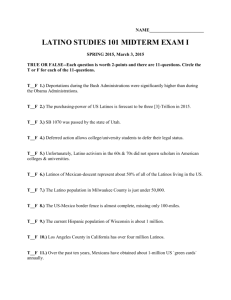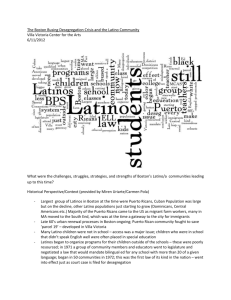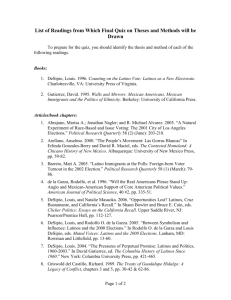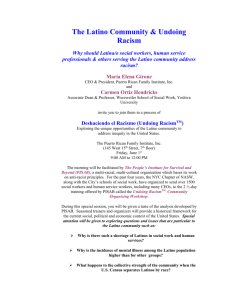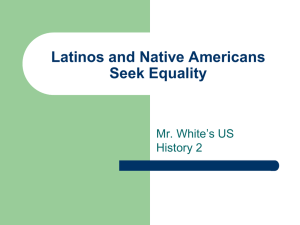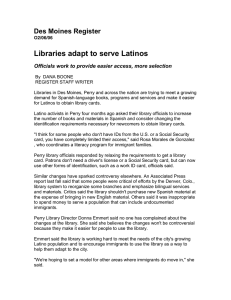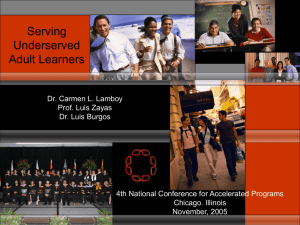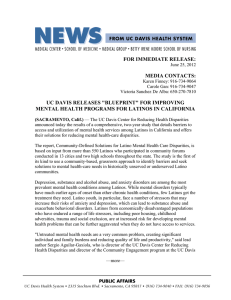Effectively Teaching Technologia en Espanol to - Oregon State 4-H
advertisement
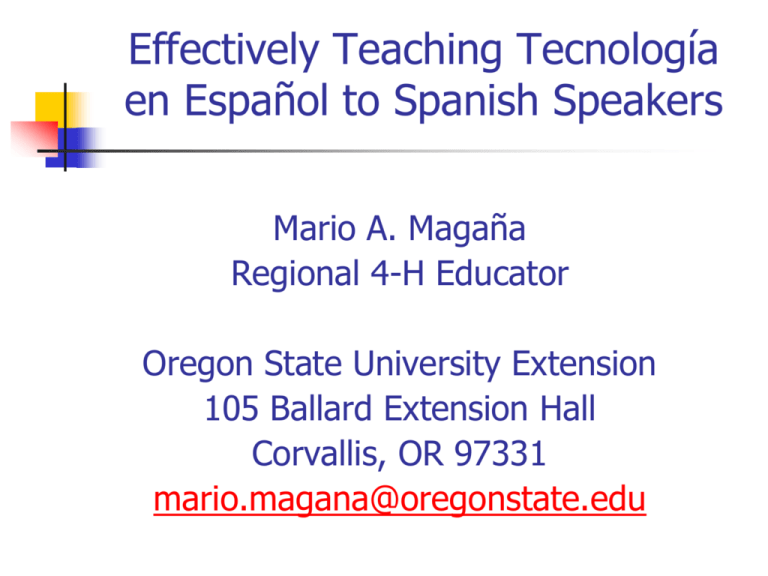
Effectively Teaching Tecnología en Español to Spanish Speakers Mario A. Magaña Regional 4-H Educator Oregon State University Extension 105 Ballard Extension Hall Corvallis, OR 97331 mario.magana@oregonstate.edu Goal of Presentation To provide an overview on how to teach computer classes to Spanish-speaking audiences. Topics Why the Latino audience Why computer classes Getting started Recruiting students Finding a computer lab Scheduling Instructors Topics Retention of volunteers Teaching strategies Curriculum Outcomes Challenges Trust building What we have learned Why the Latino Audience… By the Year 2020 in the US 1 in 4 new workers in the US will be Latino. The Latino population will increase by 60 million. This indicates the Latino labor force will increase by 56%, while the non-Latino labor force is projected to grow by 9%. Latino Population Projections Percentage of Latinos in the U.S. Year 2010: 15.5% Year 2050: 24.4% Source: U.S. Census Bureau. 2004. U.S. Interim Projections by Age, Sex, Race, and Hispanic Origin. Washington, DC: U.S. Census Bureau. Why Technology for Latinos? The U.S. workforce will depend in large part on Latinos in the near future. Military operations. Business community. Higher education system. Political institutions. Health care system. Religious institutions. What Does This All Mean? Invest today in the preparation of Latinos for the future. An unskilled or uneducated workforce cannot compete in a global economy. Getting Started Community Needs Assessment. To find out if this is a need or interest. Focus groups to identify needs/resources. Meet with community leaders. Meet well established people. Attend Hispanic organizations’ meetings. Collaborate with church groups. Partner with public schools, colleges, etc. Get to Know the Community Are the people immigrants? From what countries? Mono-lingual parents vs. bilingual kids. Low literacy in both languages. American born, first/second generation. Other differences? Building Relationships with the Majority Community Be patient. Be willing to step out of the norm. Develop allies. Identify funding opportunities. Walk your talk. Recruiting Students What do they want to Learn? Door-to-door invitation. Connect with organizations and leaders in the community to get the word out. Promote your classes in churches, schools, meetings, on radio, with flyers, etc. Offer classes that attract adults and meet the needs of their children. Classes to meet the community's workforce. Finding Your Computer Lab Accessible and well known to audience. Write grants for computers. Partner with public schools and community colleges for computer labs. Setting the Schedule Time of day and days of the week. Length of each class: 1-2 hours. How many classes? 6-8 per session. If offer adults class only, arrange (4-H activities) for children. Be true to the schedule. If you can’t make it, you may hire a substitute, but people may not come. Trust factor. Reliable and constant instructor. Instructors: Staff or Volunteers Identify volunteers/staff with teaching experience and technology skills. Do not accept people just because they want to help, unless you plan to train them. Extend a personal invitation and be specific about your request and their commitment. Recruit professionals that want to give back to the community. College students internships: For teaching and developing curriculums. Retention of Volunteers Recognition at the end of the year. Support them with materials and $ as needed. Provide training opportunities to build skills. Acknowledge their work. Treat them with respect. Support them when they have problems. Teaching Classes What are the goals for the classes? For adults to find new jobs or to communicate with family. For youth to gain confidence to take regular computer classes. Where do you start? At the beginner level; unless teaching professionals. Teaching Classes How many students per class? 5-15 and 10-20 with teacher’s assistant. How many to a computer? One per computer or two if they are a married couple or a parent of a child less than 12 years old. What teaching strategies work? Hands on activities. Separated vs. mixed classes. Elementary and middle school kids OK with parents. High school youth do better alone or working with adults NOT their parents. Extra help in the classroom. Use Spanish, but introduce English terms. Students working together. Curriculum Printed curriculum vs. delivering all instruction verbally. Spanish vs. English issues. Find a bilingual instructor with teaching experience. All explanations should be done in Spanish. But because all the software is in English, teach all the vocabulary in English and Spanish. Curriculum Using existing curriculums. A written curriculum is not the best way to teach people who don’t read, write or know how to follow a curriculum. Curriculums found to work well. Develop your own curriculum. What do they enjoy or need? Word, Excel, PowerPoint, E-Mail, Internet, and Publisher. Outcomes Students gained enough confidence to enroll in regular computer classes. Adults applied knowledge to jobs. Children and youth communicate with other family members by email. Challenges Funding: Soft funding issues. Retaining volunteers. Hard to find Latinos with technology skills. Recruiting bilingual teachers Scheduling classes: Evenings and weekends. People do not have flexible jobs. Transportation: only one car in the family. Tips To Build Trust Embrace the family aspect. Look for staff preferably of the same culture. Learn some Spanish. Value culture, tradition, and language. Respect myths. Do not use stereotypes Tips To Build Trust Be honest with yourself. Get to know your audience. Slowly acclimate yourself. Find community leaders. Don’t be afraid. Think of new ways of doing things. Deliberate intent. We Have Learned That: Working with Latinos is not easy. It can take years to build trust. Additional money and energy is needed. Personal invitations really work. Paperwork discourages Latinos. Sometimes a “Yes” really means “NO”. We need to be sincere, clear, open minded, patient, helpful, supportive, respectful, caring, truthful, and most of all friendly. “Gracias” Mario A. Magaña Regional 4-H Educator Oregon State University Extension 105 Ballard Extension Hall Corvallis, OR 97331 Phone: 541-737-0925 mario.magana@oregonstate.edu


